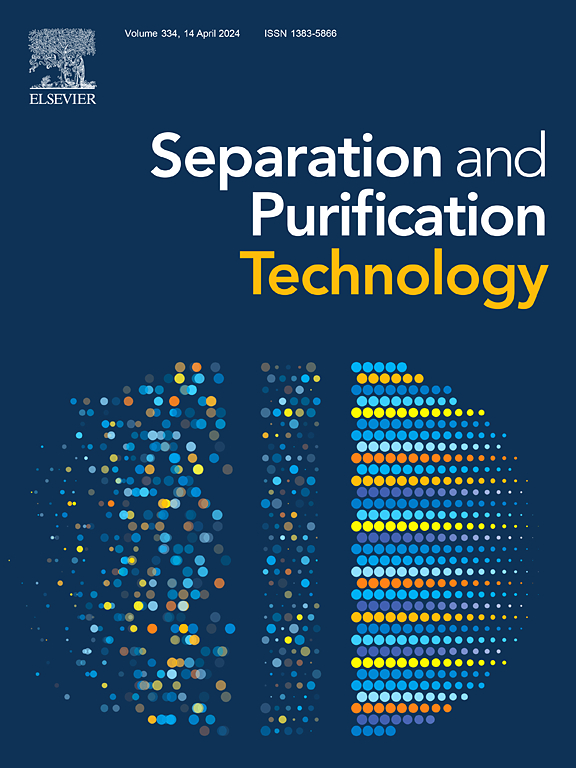在可见光下通过过硫酸盐活化降解氧氟沙星的可回收生物仿生花膜
IF 8.1
1区 工程技术
Q1 ENGINEERING, CHEMICAL
引用次数: 0
摘要
结合光催化和 PMS 活化技术构建新型氧氟沙星降解催化剂对水资源的再生具有重要意义。本研究采用溶剂热法合成了一种具有仿生花结构的三元金属(钴、锌和钼)硫化物异质结。然后采用研究的溶剂辅助纳米粒子包埋(SANE)法合成了 PVDF@CoZnMoSx 膜,在 PMS 活化作用下,该膜能高效降解氧氟沙星(OFX)(97.1%)。观察了实际环境(如共存离子、有机物和实际水基质)对 OFX 降解的影响,PVDF@CoZnMoSx-3(Zn:Co = 3:1,PCZM3)对这些因素表现出良好的耐受性和实际应用价值。LC-MS 分析明确了 OFX 降解的途径,T.E.S.T 软件模拟了 LC-MS 得到的中间产物(P1-P20)的毒性,证实了 PCZM3/PMS 系统在 OFX 降解中的有效性和安全性。可重复使用性和稳定性分析表明,PCZM3/PMS 系统对 OFX 的降解可连续保持 5 个周期,无需额外处理,且在 OFX 降解过程中会有少量离子(钴、锌和钼)被浸出。总之,该研究提出了一种构建多元金属硫化膜并将光催化与 PMS 活化耦合的新策略,为催化剂膜的性能优化提供了新的思路。本文章由计算机程序翻译,如有差异,请以英文原文为准。
Recyclable biomimetic flower membranes for ofloxacin degradation by peroxymonosulfate activation under visible-light
The construction of a novel ofloxacin degradation catalyst coupled with photocatalysis and PMS activation is of great significance for the regeneration of water resources. A ternary metal (Co, Zn and Mo) sulfide heterojunction with biomimetic flower structure was synthesized using the solvent heat method. And then PVDF@CoZnMoSx membranes were synthetised by researched solvent-assisted nanoparticle embedding (SANE) method, which yielded efficient ofloxacian (OFX) degradation (97.1 %) by PMS activation. The effects of actual environment (such as co-exist ions, organic matter, and actual water matrices) on OFX degradation were observed, and PVDF@CoZnMoSx-3 (Zn:Co = 3:1, PCZM3) exhibited good tolerance for these factors and application value in practice. The pathways of OFX degradation were clarified by LC-MS analysis, and T.E.S.T software simulated the toxicity of the intermediates (P1-P20) gained from LC-MS, which substantiated the efficacy and safety of the PCZM3/PMS system in OFX degradation. The reusability and stability analysis displayed that the OFX degradation of PCZM3/PMS system was maintained in 5 consecutive cycles without additional treatment, and a small number of ions (Co, Zn and Mo) were leached during the OFX degradation. Totally, a new strategy was raised to construct multivariate metal sulfide membranes and couple the photocatalysis and PMS activation, which provided new insights for catalyst membranes to optimize performance.
求助全文
通过发布文献求助,成功后即可免费获取论文全文。
去求助
来源期刊

Separation and Purification Technology
工程技术-工程:化工
CiteScore
14.00
自引率
12.80%
发文量
2347
审稿时长
43 days
期刊介绍:
Separation and Purification Technology is a premier journal committed to sharing innovative methods for separation and purification in chemical and environmental engineering, encompassing both homogeneous solutions and heterogeneous mixtures. Our scope includes the separation and/or purification of liquids, vapors, and gases, as well as carbon capture and separation techniques. However, it's important to note that methods solely intended for analytical purposes are not within the scope of the journal. Additionally, disciplines such as soil science, polymer science, and metallurgy fall outside the purview of Separation and Purification Technology. Join us in advancing the field of separation and purification methods for sustainable solutions in chemical and environmental engineering.
 求助内容:
求助内容: 应助结果提醒方式:
应助结果提醒方式:


